Page 25 of 89
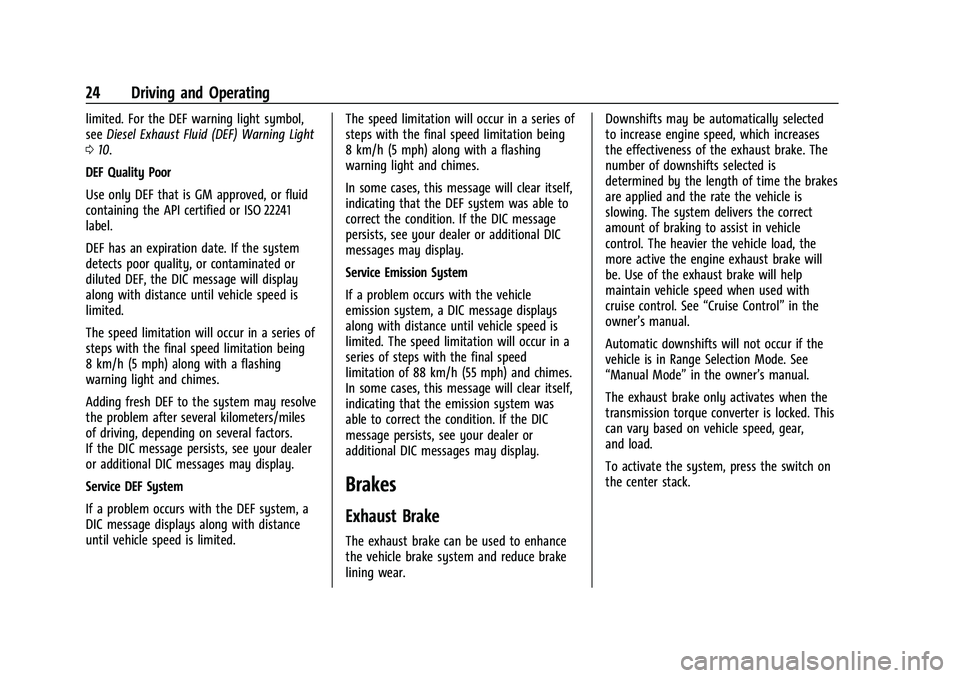
Chevrolet/GMC 2.8L Duramax Diesel Engine Supplement (GMNA-Localizing-
U.S./Canada-14465442) - 2021 - CRC - 2/3/20
24 Driving and Operating
limited. For the DEF warning light symbol,
seeDiesel Exhaust Fluid (DEF) Warning Light
0 10.
DEF Quality Poor
Use only DEF that is GM approved, or fluid
containing the API certified or ISO 22241
label.
DEF has an expiration date. If the system
detects poor quality, or contaminated or
diluted DEF, the DIC message will display
along with distance until vehicle speed is
limited.
The speed limitation will occur in a series of
steps with the final speed limitation being
8 km/h (5 mph) along with a flashing
warning light and chimes.
Adding fresh DEF to the system may resolve
the problem after several kilometers/miles
of driving, depending on several factors.
If the DIC message persists, see your dealer
or additional DIC messages may display.
Service DEF System
If a problem occurs with the DEF system, a
DIC message displays along with distance
until vehicle speed is limited. The speed limitation will occur in a series of
steps with the final speed limitation being
8 km/h (5 mph) along with a flashing
warning light and chimes.
In some cases, this message will clear itself,
indicating that the DEF system was able to
correct the condition. If the DIC message
persists, see your dealer or additional DIC
messages may display.
Service Emission System
If a problem occurs with the vehicle
emission system, a DIC message displays
along with distance until vehicle speed is
limited. The speed limitation will occur in a
series of steps with the final speed
limitation of 88 km/h (55 mph) and chimes.
In some cases, this message will clear itself,
indicating that the emission system was
able to correct the condition. If the DIC
message persists, see your dealer or
additional DIC messages may display.
Brakes
Exhaust Brake
The exhaust brake can be used to enhance
the vehicle brake system and reduce brake
lining wear.Downshifts may be automatically selected
to increase engine speed, which increases
the effectiveness of the exhaust brake. The
number of downshifts selected is
determined by the length of time the brakes
are applied and the rate the vehicle is
slowing. The system delivers the correct
amount of braking to assist in vehicle
control. The heavier the vehicle load, the
more active the engine exhaust brake will
be. Use of the exhaust brake will help
maintain vehicle speed when used with
cruise control. See
“Cruise Control”in the
owner’s manual.
Automatic downshifts will not occur if the
vehicle is in Range Selection Mode. See
“Manual Mode” in the owner’s manual.
The exhaust brake only activates when the
transmission torque converter is locked. This
can vary based on vehicle speed, gear,
and load.
To activate the system, press the switch on
the center stack.
Page 26 of 89
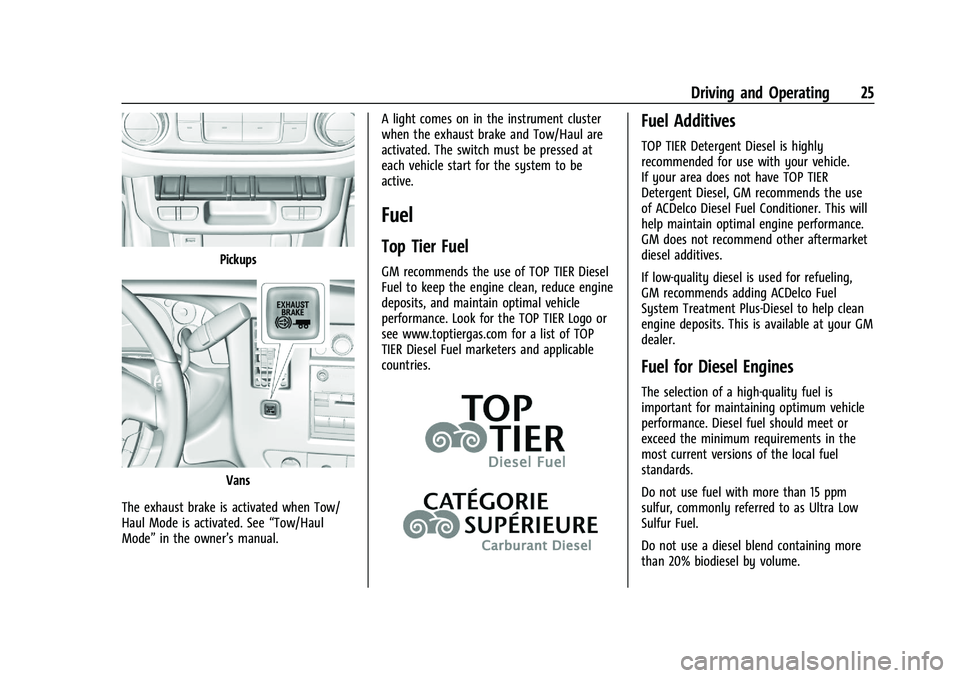
Chevrolet/GMC 2.8L Duramax Diesel Engine Supplement (GMNA-Localizing-
U.S./Canada-14465442) - 2021 - CRC - 2/3/20
Driving and Operating 25
Pickups
Vans
The exhaust brake is activated when Tow/
Haul Mode is activated. See “Tow/Haul
Mode” in the owner’s manual. A light comes on in the instrument cluster
when the exhaust brake and Tow/Haul are
activated. The switch must be pressed at
each vehicle start for the system to be
active.
Fuel
Top Tier Fuel
GM recommends the use of TOP TIER Diesel
Fuel to keep the engine clean, reduce engine
deposits, and maintain optimal vehicle
performance. Look for the TOP TIER Logo or
see www.toptiergas.com for a list of TOP
TIER Diesel Fuel marketers and applicable
countries.
Fuel Additives
TOP TIER Detergent Diesel is highly
recommended for use with your vehicle.
If your area does not have TOP TIER
Detergent Diesel, GM recommends the use
of ACDelco Diesel Fuel Conditioner. This will
help maintain optimal engine performance.
GM does not recommend other aftermarket
diesel additives.
If low-quality diesel is used for refueling,
GM recommends adding ACDelco Fuel
System Treatment Plus-Diesel to help clean
engine deposits. This is available at your GM
dealer.
Fuel for Diesel Engines
The selection of a high-quality fuel is
important for maintaining optimum vehicle
performance. Diesel fuel should meet or
exceed the minimum requirements in the
most current versions of the local fuel
standards.
Do not use fuel with more than 15 ppm
sulfur, commonly referred to as Ultra Low
Sulfur Fuel.
Do not use a diesel blend containing more
than 20% biodiesel by volume.
Page 27 of 89
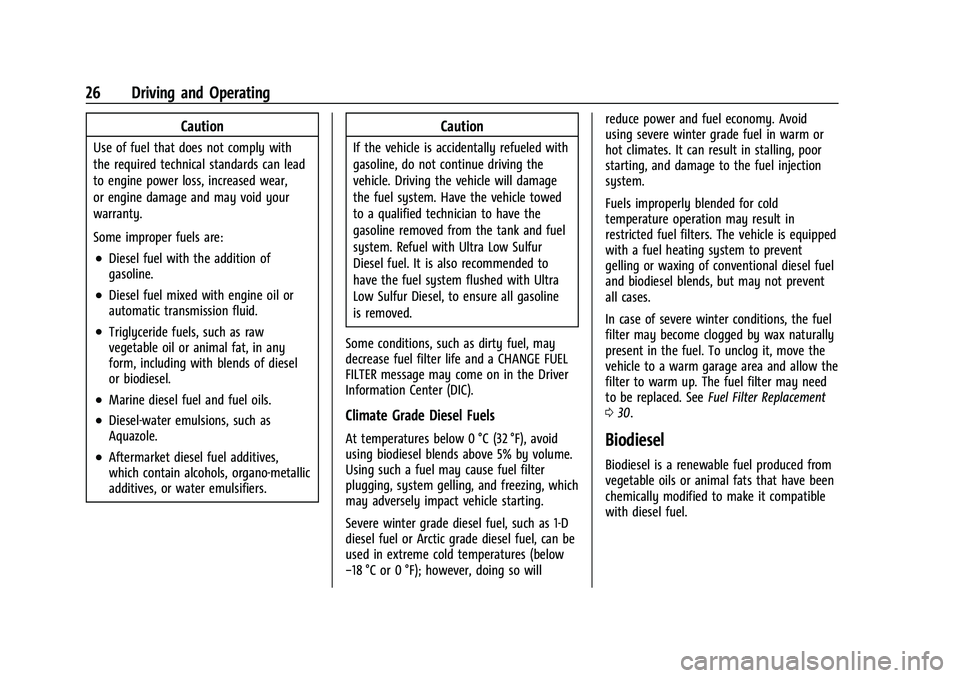
Chevrolet/GMC 2.8L Duramax Diesel Engine Supplement (GMNA-Localizing-
U.S./Canada-14465442) - 2021 - CRC - 2/3/20
26 Driving and Operating
Caution
Use of fuel that does not comply with
the required technical standards can lead
to engine power loss, increased wear,
or engine damage and may void your
warranty.
Some improper fuels are:
.Diesel fuel with the addition of
gasoline.
.Diesel fuel mixed with engine oil or
automatic transmission fluid.
.Triglyceride fuels, such as raw
vegetable oil or animal fat, in any
form, including with blends of diesel
or biodiesel.
.Marine diesel fuel and fuel oils.
.Diesel-water emulsions, such as
Aquazole.
.Aftermarket diesel fuel additives,
which contain alcohols, organo-metallic
additives, or water emulsifiers.
Caution
If the vehicle is accidentally refueled with
gasoline, do not continue driving the
vehicle. Driving the vehicle will damage
the fuel system. Have the vehicle towed
to a qualified technician to have the
gasoline removed from the tank and fuel
system. Refuel with Ultra Low Sulfur
Diesel fuel. It is also recommended to
have the fuel system flushed with Ultra
Low Sulfur Diesel, to ensure all gasoline
is removed.
Some conditions, such as dirty fuel, may
decrease fuel filter life and a CHANGE FUEL
FILTER message may come on in the Driver
Information Center (DIC).
Climate Grade Diesel Fuels
At temperatures below 0 °C (32 °F), avoid
using biodiesel blends above 5% by volume.
Using such a fuel may cause fuel filter
plugging, system gelling, and freezing, which
may adversely impact vehicle starting.
Severe winter grade diesel fuel, such as 1-D
diesel fuel or Arctic grade diesel fuel, can be
used in extreme cold temperatures (below
−18 °C or 0 °F); however, doing so will reduce power and fuel economy. Avoid
using severe winter grade fuel in warm or
hot climates. It can result in stalling, poor
starting, and damage to the fuel injection
system.
Fuels improperly blended for cold
temperature operation may result in
restricted fuel filters. The vehicle is equipped
with a fuel heating system to prevent
gelling or waxing of conventional diesel fuel
and biodiesel blends, but may not prevent
all cases.
In case of severe winter conditions, the fuel
filter may become clogged by wax naturally
present in the fuel. To unclog it, move the
vehicle to a warm garage area and allow the
filter to warm up. The fuel filter may need
to be replaced. See
Fuel Filter Replacement
0 30.Biodiesel
Biodiesel is a renewable fuel produced from
vegetable oils or animal fats that have been
chemically modified to make it compatible
with diesel fuel.
Page 28 of 89
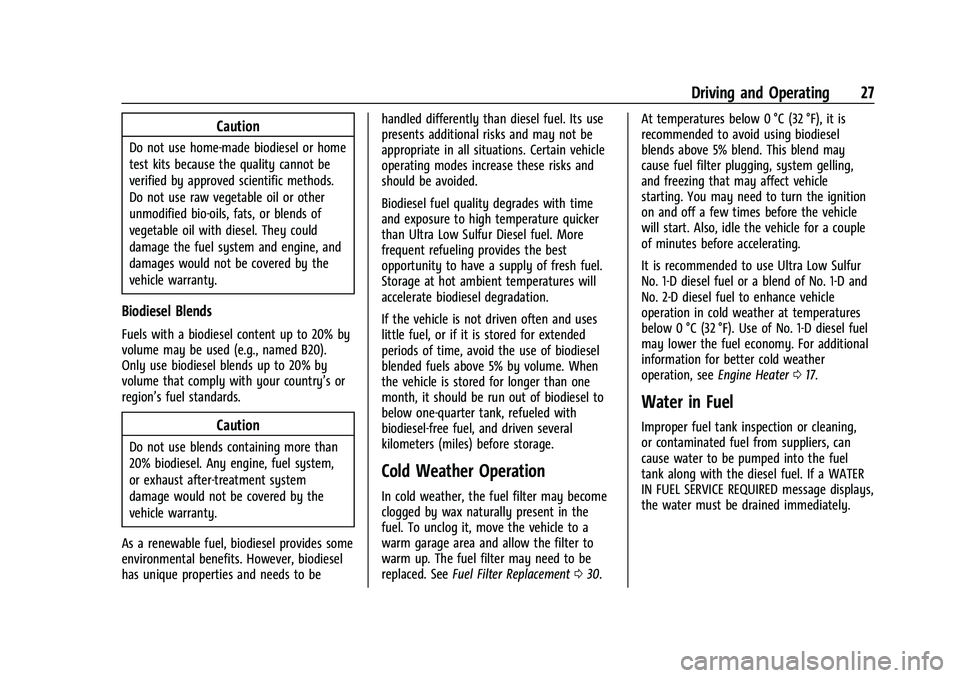
Chevrolet/GMC 2.8L Duramax Diesel Engine Supplement (GMNA-Localizing-
U.S./Canada-14465442) - 2021 - CRC - 2/3/20
Driving and Operating 27
Caution
Do not use home-made biodiesel or home
test kits because the quality cannot be
verified by approved scientific methods.
Do not use raw vegetable oil or other
unmodified bio-oils, fats, or blends of
vegetable oil with diesel. They could
damage the fuel system and engine, and
damages would not be covered by the
vehicle warranty.
Biodiesel Blends
Fuels with a biodiesel content up to 20% by
volume may be used (e.g., named B20).
Only use biodiesel blends up to 20% by
volume that comply with your country’s or
region’s fuel standards.
Caution
Do not use blends containing more than
20% biodiesel. Any engine, fuel system,
or exhaust after-treatment system
damage would not be covered by the
vehicle warranty.
As a renewable fuel, biodiesel provides some
environmental benefits. However, biodiesel
has unique properties and needs to be handled differently than diesel fuel. Its use
presents additional risks and may not be
appropriate in all situations. Certain vehicle
operating modes increase these risks and
should be avoided.
Biodiesel fuel quality degrades with time
and exposure to high temperature quicker
than Ultra Low Sulfur Diesel fuel. More
frequent refueling provides the best
opportunity to have a supply of fresh fuel.
Storage at hot ambient temperatures will
accelerate biodiesel degradation.
If the vehicle is not driven often and uses
little fuel, or if it is stored for extended
periods of time, avoid the use of biodiesel
blended fuels above 5% by volume. When
the vehicle is stored for longer than one
month, it should be run out of biodiesel to
below one-quarter tank, refueled with
biodiesel-free fuel, and driven several
kilometers (miles) before storage.
Cold Weather Operation
In cold weather, the fuel filter may become
clogged by wax naturally present in the
fuel. To unclog it, move the vehicle to a
warm garage area and allow the filter to
warm up. The fuel filter may need to be
replaced. See
Fuel Filter Replacement 030. At temperatures below 0 °C (32 °F), it is
recommended to avoid using biodiesel
blends above 5% blend. This blend may
cause fuel filter plugging, system gelling,
and freezing that may affect vehicle
starting. You may need to turn the ignition
on and off a few times before the vehicle
will start. Also, idle the vehicle for a couple
of minutes before accelerating.
It is recommended to use Ultra Low Sulfur
No. 1-D diesel fuel or a blend of No. 1-D and
No. 2-D diesel fuel to enhance vehicle
operation in cold weather at temperatures
below 0 °C (32 °F). Use of No. 1-D diesel fuel
may lower the fuel economy. For additional
information for better cold weather
operation, see
Engine Heater017.
Water in Fuel
Improper fuel tank inspection or cleaning,
or contaminated fuel from suppliers, can
cause water to be pumped into the fuel
tank along with the diesel fuel. If a WATER
IN FUEL SERVICE REQUIRED message displays,
the water must be drained immediately.
Page 29 of 89
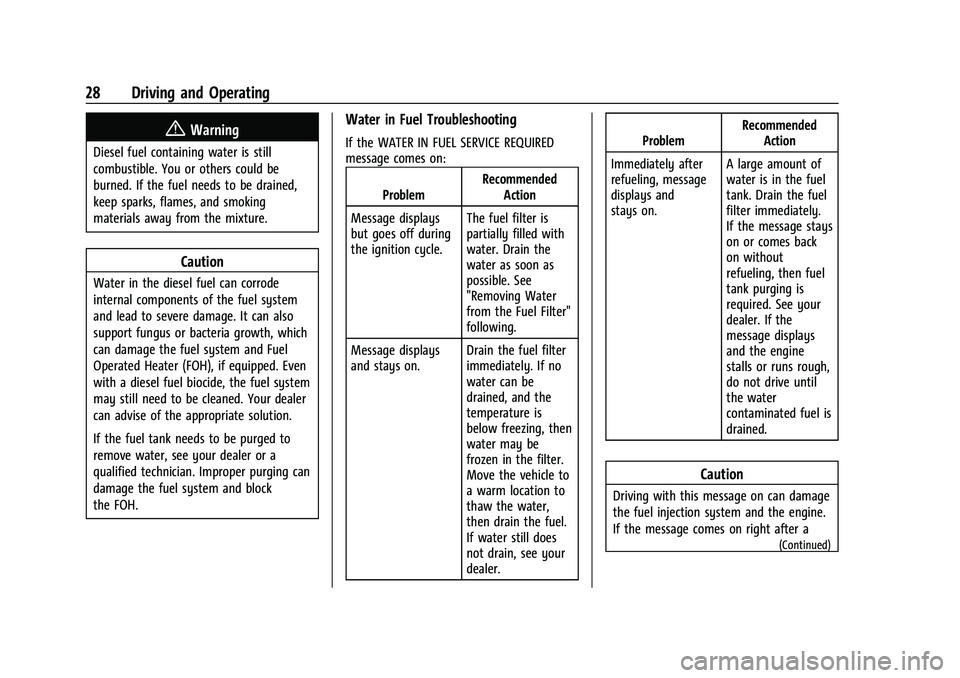
Chevrolet/GMC 2.8L Duramax Diesel Engine Supplement (GMNA-Localizing-
U.S./Canada-14465442) - 2021 - CRC - 2/3/20
28 Driving and Operating
{Warning
Diesel fuel containing water is still
combustible. You or others could be
burned. If the fuel needs to be drained,
keep sparks, flames, and smoking
materials away from the mixture.
Caution
Water in the diesel fuel can corrode
internal components of the fuel system
and lead to severe damage. It can also
support fungus or bacteria growth, which
can damage the fuel system and Fuel
Operated Heater (FOH), if equipped. Even
with a diesel fuel biocide, the fuel system
may still need to be cleaned. Your dealer
can advise of the appropriate solution.
If the fuel tank needs to be purged to
remove water, see your dealer or a
qualified technician. Improper purging can
damage the fuel system and block
the FOH.
Water in Fuel Troubleshooting
If the WATER IN FUEL SERVICE REQUIRED
message comes on:Problem Recommended
Action
Message displays
but goes off during
the ignition cycle. The fuel filter is
partially filled with
water. Drain the
water as soon as
possible. See
"Removing Water
from the Fuel Filter"
following.
Message displays
and stays on. Drain the fuel filter
immediately. If no
water can be
drained, and the
temperature is
below freezing, then
water may be
frozen in the filter.
Move the vehicle to
a warm location to
thaw the water,
then drain the fuel.
If water still does
not drain, see your
dealer. Problem
Recommended
Action
Immediately after
refueling, message
displays and
stays on. A large amount of
water is in the fuel
tank. Drain the fuel
filter immediately.
If the message stays
on or comes back
on without
refueling, then fuel
tank purging is
required. See your
dealer. If the
message displays
and the engine
stalls or runs rough,
do not drive until
the water
contaminated fuel is
drained.
Caution
Driving with this message on can damage
the fuel injection system and the engine.
If the message comes on right after a
(Continued)
Page 30 of 89

Chevrolet/GMC 2.8L Duramax Diesel Engine Supplement (GMNA-Localizing-
U.S./Canada-14465442) - 2021 - CRC - 2/3/20
Driving and Operating 29
Caution (Continued)
refuel, water was pumped into the fuel
tank. Turn off the engine and drain the
water immediately.
Removing Water from the Fuel Filter
To drain water:1. Turn the engine off and apply the parking brake.
Van
Pickup
2. Place a container under the filter drain valve. The filter drain valve is on the
bottom of the fuel filter. The filter drain
valve is under the vehicle on the driver
side, inside the frame rail.
3. For van models, open the drain valve by turning it counterclockwise. Allow the
filter to drain until all of the water has
been removed. Close the valve.
For pickup models, open the fuel filter
cap by turning it two to three turns.
Allow the filter to drain until all of the
water has been removed. Close the cap
hand tight. 4. Properly dispose of the water
contaminated fuel.
5. Start the engine and let it run for a few minutes. During the draining process, air
may have entered the fuel system. If the
engine stalls, the fuel system may need
to be primed. See “Fuel Priming”
following.
Fuel Priming
For the fuel system to work properly, the
fuel lines must be full of fuel. If air gets in,
the fuel lines need to be primed before
operating the vehicle and the Fuel Operated
Heater (FOH).
If air is present, the following may have
happened:
.The vehicle ran out of fuel.
.The fuel filter was removed.
.The fuel lines were removed or
disconnected.
.The fuel filter water drain valve was
opened while the engine was running.
.The FOH pump and FOH fuel lines were
removed or disconnected.
Page 31 of 89

Chevrolet/GMC 2.8L Duramax Diesel Engine Supplement (GMNA-Localizing-
U.S./Canada-14465442) - 2021 - CRC - 2/3/20
30 Driving and Operating
The system is not harmed by air in the fuel
lines; however, the engine and/or the FOH
may not start until the fuel system is
primed and the air is removed.
Priming the Fuel System
There is an electric priming pump that will
bring fuel to the engine and eliminate air in
the fuel lines. To prime the engine:1. Correct any condition that caused the loss of prime.
2. Turn the ignition on for 30 seconds. Do not start the engine. The fuel pump will
start priming.
3. Turn the ignition off, then back to start, and crank the engine for 15 seconds.
4. If the engine does not start, repeat Steps 2 and 3 until the engine starts.
If the engine does not start after
repeating Steps 2 and 3 three times, turn
the ignition key off for 60 seconds.
5. Repeat the above steps until the engine starts.
6. If the engine starts, but does not run smoothly, increase the engine speed
slightly. 7. If the engine starts and runs but stalls
again, turn the ignition off for
60 seconds.
8. When the engine starts, let it idle for a few minutes and check the filter for any
leaks.
To Prime the Fuel Operated Heater (FOH)
Fuel Lines (Van Models)
See your dealer or qualified technician if the
FOH fuel lines need to be primed.
Running Out of Fuel
If the engine has stalled due to running out
of fuel, try to restart it: 1. If parked on a level surface, add at least 3.8 L (1 gal) of fuel. Up to 18.9 L (5 gal)
may be needed if parked on a slope.
2. Follow the vehicle fuel system priming procedure earlier in this section to
re-prime the system and restart the
engine.
If the check engine light comes on due to
running out of fuel, it may take a few drive
cycles to clear.
On van models only, the Fuel Operated
Heater (FOH) stops automatically when the
fuel tank volume is less than or equal to 10% of the total tank. The FOH fuel lines
will not need to be primed if the vehicle
runs out of fuel.
Fuel Filter Replacement
Van Models
{Warning
Diesel fuel is flammable. It could start a
fire if something ignites it, and people
could be burned. Do not let it get on hot
engine parts, and keep matches or other
ignition sources away.
The fuel filter is on the driver side, inside
the frame rail.
To replace the fuel filter: 1. Drain any water from the filter. See “Removing Water from the Fuel Filter” in
Water in Fuel 027.
Keep the engine off until the procedure
is completed.
2. Apply the parking brake.
Page 32 of 89
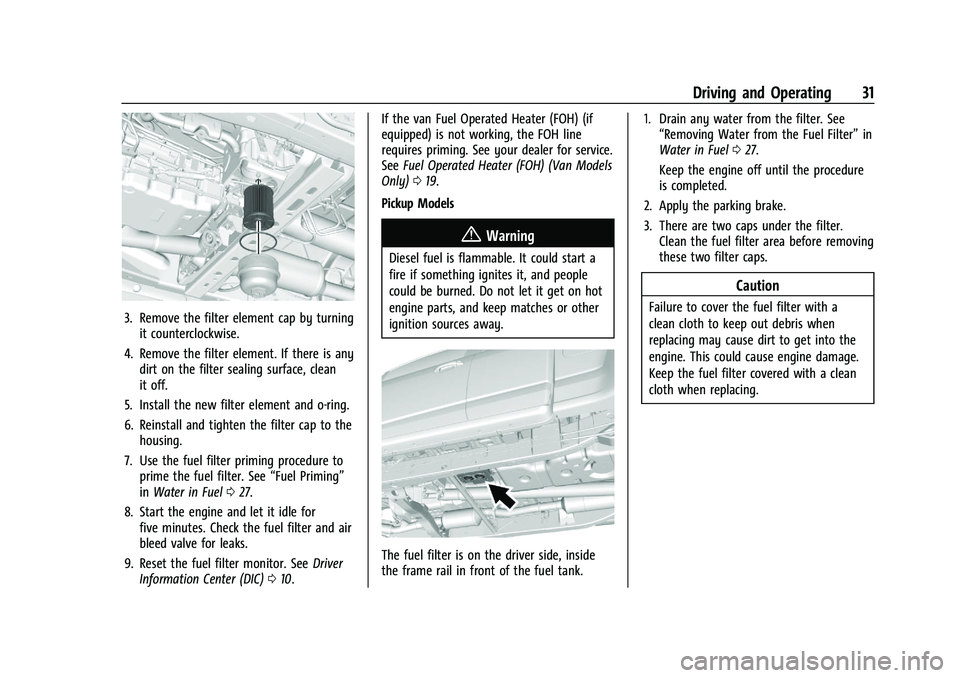
Chevrolet/GMC 2.8L Duramax Diesel Engine Supplement (GMNA-Localizing-
U.S./Canada-14465442) - 2021 - CRC - 2/3/20
Driving and Operating 31
3. Remove the filter element cap by turningit counterclockwise.
4. Remove the filter element. If there is any dirt on the filter sealing surface, clean
it off.
5. Install the new filter element and o-ring.
6. Reinstall and tighten the filter cap to the housing.
7. Use the fuel filter priming procedure to prime the fuel filter. See “Fuel Priming”
in Water in Fuel 027.
8. Start the engine and let it idle for five minutes. Check the fuel filter and air
bleed valve for leaks.
9. Reset the fuel filter monitor. See Driver
Information Center (DIC) 010. If the van Fuel Operated Heater (FOH) (if
equipped) is not working, the FOH line
requires priming. See your dealer for service.
See
Fuel Operated Heater (FOH) (Van Models
Only) 019.
Pickup Models
{Warning
Diesel fuel is flammable. It could start a
fire if something ignites it, and people
could be burned. Do not let it get on hot
engine parts, and keep matches or other
ignition sources away.
The fuel filter is on the driver side, inside
the frame rail in front of the fuel tank. 1. Drain any water from the filter. See
“Removing Water from the Fuel Filter” in
Water in Fuel 027.
Keep the engine off until the procedure
is completed.
2. Apply the parking brake.
3. There are two caps under the filter. Clean the fuel filter area before removing
these two filter caps.
Caution
Failure to cover the fuel filter with a
clean cloth to keep out debris when
replacing may cause dirt to get into the
engine. This could cause engine damage.
Keep the fuel filter covered with a clean
cloth when replacing.